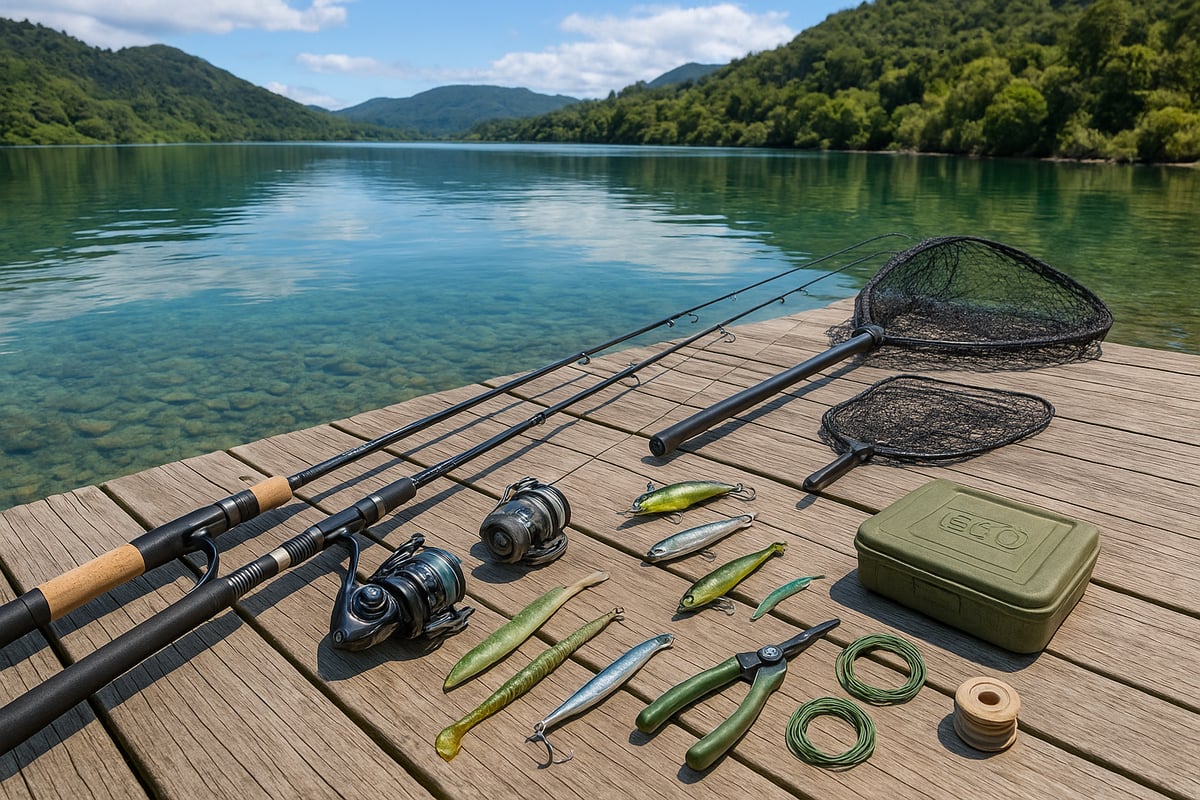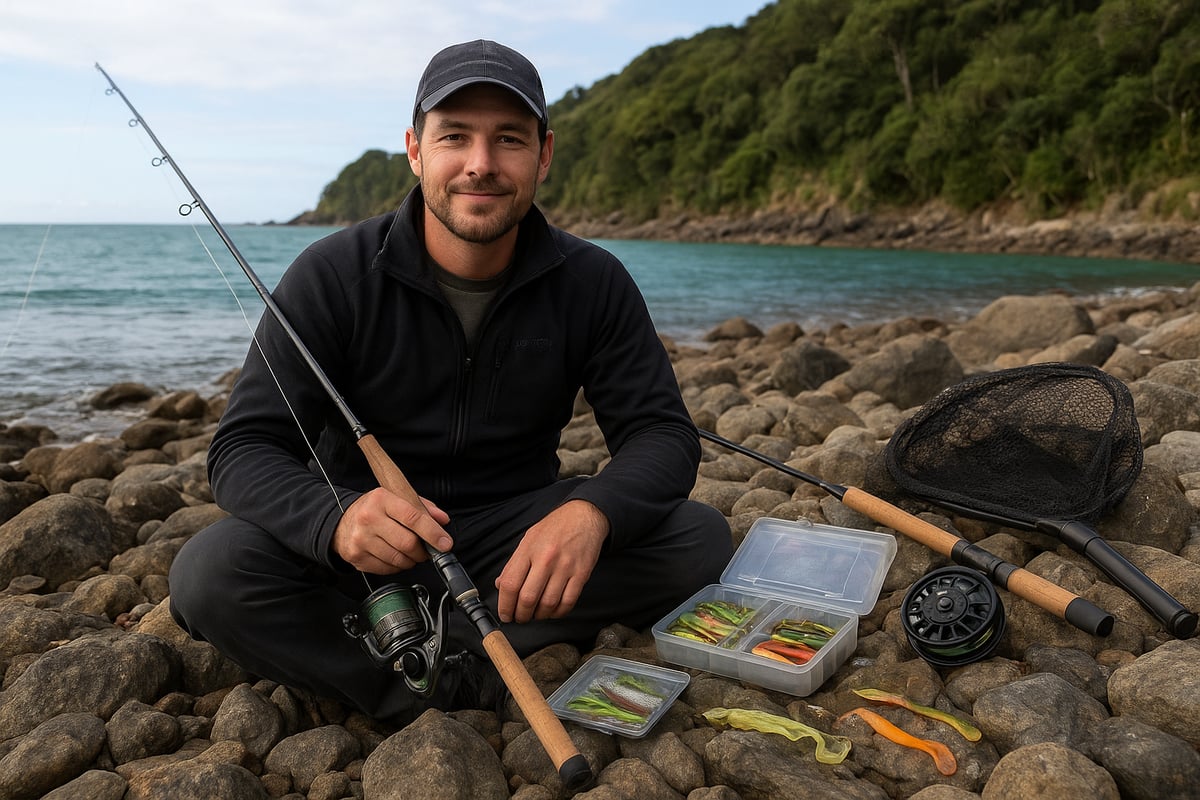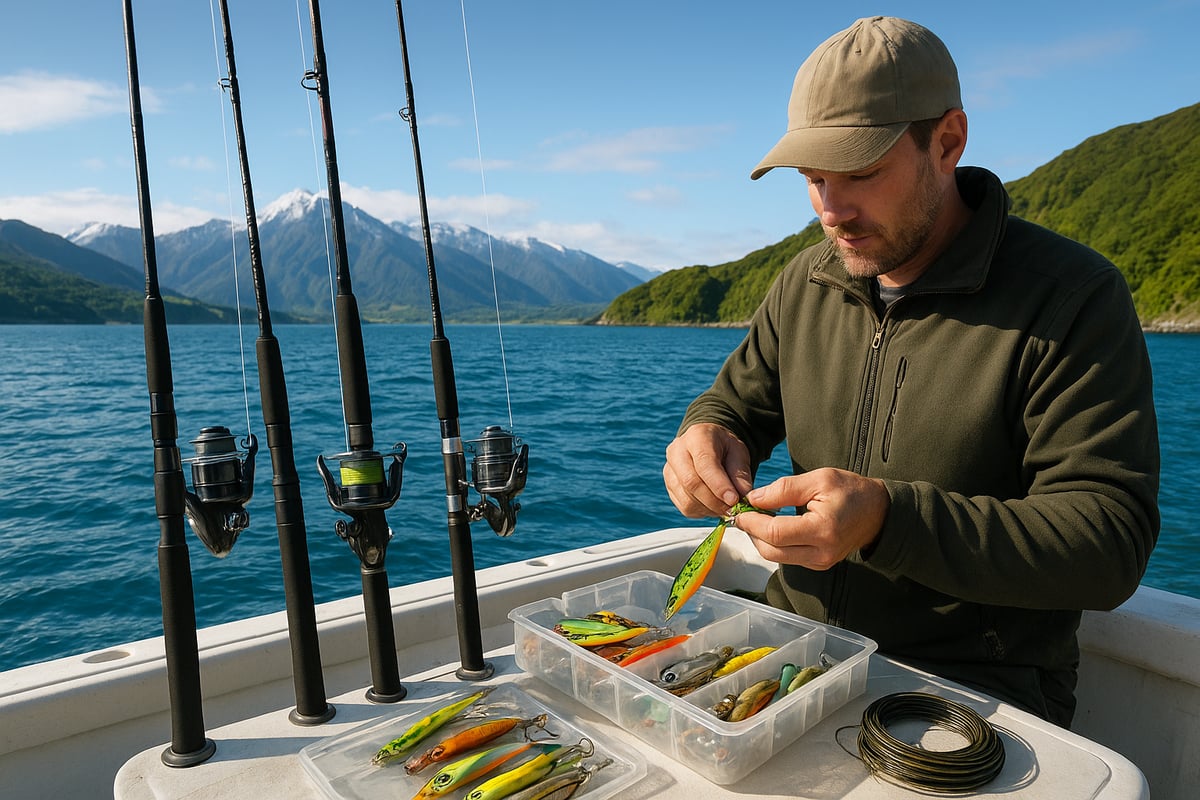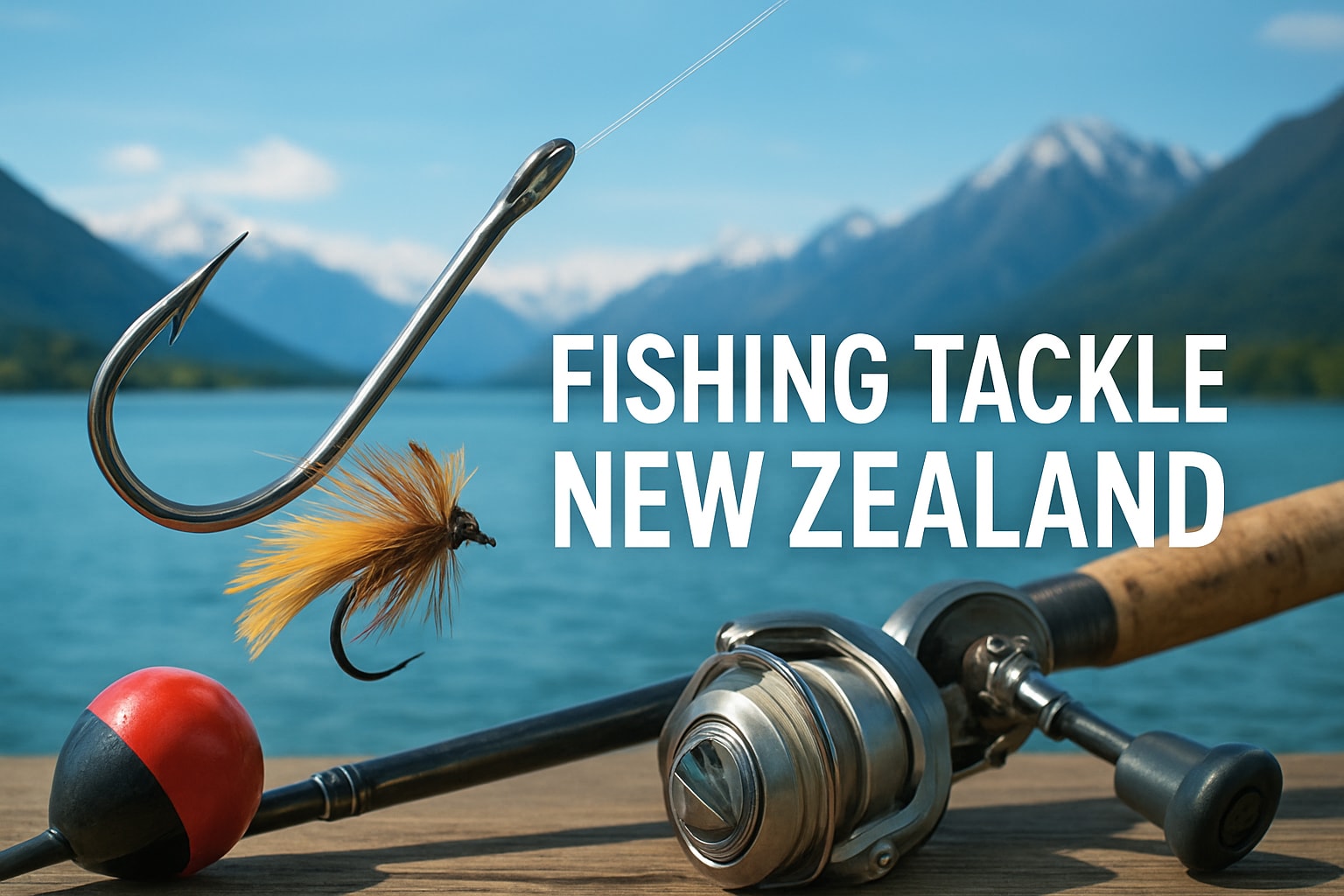New Zealand’s pristine waters are a paradise for anglers, but success often depends on having the right fishing tackle new zealand. The right gear can mean the difference between a memorable catch and a missed opportunity.
This expert’s guide is designed to help both seasoned pros and first-time fishers confidently navigate fishing tackle new zealand for 2025. You will learn how to select, use, and care for tackle that suits local species, environments, and regulations.
Inside, discover essential tackle types, top brands, and region-specific tips. Explore expert selection advice, maintenance strategies, and the latest gear trends. Make informed choices and maximize your fishing adventures in New Zealand.
Understanding Fishing Tackle in New Zealand
Fishing tackle New Zealand is far more than just rods and reels—it's a carefully chosen system designed for the country's unique waters and fish. To succeed, you need to understand what goes into your kit, adapt to local conditions, follow regulations, and choose gear that respects both technology and the environment.

What Constitutes Fishing Tackle?
At its core, fishing tackle New Zealand includes rods, reels, lines, hooks, lures, terminal tackle, and a range of accessories. Each item serves a specific purpose—rods and reels cast and retrieve, lines connect you to the fish, while lures and hooks entice and secure your catch.
There are clear differences between freshwater and saltwater tackle. Freshwater setups, for example, are often lighter and designed for species like trout. Saltwater tackle is built tougher for snapper or kingfish, with corrosion resistance a must.
Matching your tackle to the species and the environment is crucial. For instance, a snapper rig demands heavier line and sturdier hooks compared to a trout setup. With over 1.2 million recreational fishers in New Zealand, the range of available gear reflects this diversity.
Unique Challenges of NZ Waters
New Zealand’s fishing environments are diverse, from alpine lakes and swift rivers to tidal estuaries and open ocean. This variety means fishing tackle New Zealand must adapt to shifting weather, strong currents, and changing tides.
Species diversity also shapes gear choices. Snapper, kingfish, trout, and kahawai each require different setups. For example, Fiordland’s deep, cold waters challenge anglers with strong currents and rugged terrain, while the Hauraki Gulf offers more sheltered, warmer fishing grounds.
Salinity and corrosion are constant concerns in coastal areas. Durable, high-quality materials are essential if you want your tackle to last season after season.
Tackle Regulations and Compliance
To legally fish in New Zealand, understanding and following tackle regulations is vital. Rules set by the Ministry for Primary Industries (MPI) specify legal gear types, hook sizes, and daily bag limits for recreational anglers.
Nets, traps, and set lines face strict restrictions to protect fish stocks. Penalties for non-compliance can be significant, impacting both your wallet and future fishing opportunities. For example, snapper must meet a minimum legal size, and daily catch limits are enforced to ensure sustainability.
For up-to-date rules and detailed guidance, consult the New Zealand fishing regulations 2025 before planning your next trip. Staying informed helps you use fishing tackle New Zealand efficiently and responsibly.
The Role of Technology in Modern Tackle
Technology is transforming fishing tackle New Zealand, giving anglers new tools for success. Braided lines, fluorocarbon leaders, and digital reels offer greater strength, sensitivity, and reliability on the water.
Smart tackle boxes and fish finders use digital displays and sensors to help locate fish or organize gear. According to Fish & Game NZ, 40% of local anglers now use tech-enhanced equipment.
While technology can boost catch rates, it also adds complexity and cost. Balancing traditional skills with new gadgets ensures you get the best from your fishing tackle New Zealand.
Environmental Considerations
As awareness grows about the impact of fishing gear, many anglers are moving towards eco-friendly tackle choices. Biodegradable lures and lead-free sinkers help reduce pollution in New Zealand's pristine environments.
Lost tackle can harm marine life, so minimizing loss and disposing of old gear responsibly is essential. Sustainable fishing practices, such as using circle hooks to reduce bycatch, are promoted by NZ organizations.
Choosing environmentally conscious fishing tackle New Zealand not only protects the resource but also sets an example for future generations.
Essential Types of Fishing Tackle for NZ Anglers
Selecting the right fishing tackle new zealand is essential for every angler, whether you're casting for trout in crystal-clear rivers or targeting snapper in the open sea. The diversity of New Zealand's waters demands a well-equipped tackle box, so understanding each tackle type ensures you're always ready for the next big catch.

Rods and Reels: Matching Gear to Species
The foundation of any fishing tackle new zealand setup is your rod and reel. Spinning rods are popular for their versatility, handling everything from kahawai to snapper. Baitcasting rods offer precision for heavier lures and bigger species like kingfish. Fly rods are a staple in South Island rivers, especially for trout.
Choosing the right reel type is just as important. Fixed spool reels are user-friendly and ideal for beginners, while overhead reels provide more power for deep-sea fishing. Fly reels pair perfectly with lightweight setups for freshwater streams.
When selecting rods, consider length, action, and power. Longer rods cast farther, while fast-action rods provide sensitivity for species with subtle bites. For example, a 7-foot medium-action spinning combo is a favourite for snapper fishing tackle new zealand, offering balance and adaptability.
Lines, Leaders, and Terminal Tackle
The choice of line significantly impacts your fishing tackle new zealand effectiveness. Monofilament lines are affordable and forgiving, making them great for beginners. Fluorocarbon lines offer superior invisibility underwater, ideal for wary trout. Braided lines are prized for their strength and sensitivity, dominating 55 percent of NZ saltwater setups.
Leaders provide crucial abrasion resistance, especially when targeting toothy or rough-mouthed species. Terminal tackle—such as swivels, clips, and sinkers—completes your setup, ensuring secure connections and proper bait presentation.
Mastering knots is essential. Strong knots prevent break-offs and lost fish. Swapping leaders or adjusting sinker weights allows you to quickly adapt your fishing tackle new zealand to local conditions.
Hooks, Lures, and Baits
Hooks are the heart of fishing tackle new zealand. J-hooks are versatile, circle hooks reduce bycatch, and treble hooks are common on hard-bodied lures. Matching hook size to your target species is vital for effective hookups.
Artificial lures, from soft plastics to jigs and spinners, mimic local prey and trigger strikes. In the Hauraki Gulf, soft plastics are a proven choice for snapper. Natural baits like pilchard, squid, and shellfish remain favourites for many anglers.
Experiment with different lure colours and sizes to match local forage. Adapting your fishing tackle new zealand this way increases your success across regions and seasons.
Nets, Gaffs, and Landing Tools
Landing your catch safely is a key part of fishing tackle new zealand. Rubber mesh landing nets are gentle on fish, especially important for trout conservation and catch-and-release practices. Choose net size and mesh type based on your target species.
Gaffs are used for securing large fish but should be employed responsibly to avoid injuring undersized or unwanted catches. Dehookers, lip grips, and fish-friendly pliers help with safe handling and quick releases.
A well-equipped tackle box includes these essential tools. Prioritise humane handling to protect New Zealand's fisheries and get the most from your fishing tackle new zealand.
Storage, Transport, and Tackle Boxes
Proper organisation protects your investment in fishing tackle new zealand. Tackle boxes and bags keep your gear sorted and accessible, whether fishing from a boat, kayak, or onshore. Waterproof cases are invaluable for safeguarding equipment from NZ's unpredictable weather.
When transporting, secure rods and reels to prevent damage, and consider lockable storage to deter theft. For a comprehensive range of locally tailored options, visit the Online Fishing Tackle Store NZ, where you’ll find tackle boxes, storage solutions, and gear designed for New Zealand conditions.
Effective storage means you spend less time searching for gear and more time fishing, maximising the value of your fishing tackle new zealand.
Safety and Accessory Gear
Safety is non-negotiable when assembling fishing tackle new zealand. Certified life jackets are a must for boat anglers, with 85 percent compliance reported. Waders provide comfort and protection in cold rivers, while sun protection gear shields against harsh UV rays.
Every angler should carry a first aid kit and emergency signaling devices. Polarized sunglasses are invaluable for spotting fish and reducing glare, enhancing both safety and performance.
Equipping your fishing tackle new zealand with these accessories ensures you stay protected and prepared for any adventure on the water.
Regional Tackle Considerations Across New Zealand
New Zealand’s diverse geography means anglers must be strategic when selecting fishing tackle new zealand. From subtropical coasts to alpine streams, every region presents unique demands. Understanding these regional variations ensures your gear is optimized for success, no matter where you cast your line.

North Island vs. South Island Tackle Needs
The North Island features warmer waters and a greater abundance of coastal species such as snapper and kingfish. Here, fishing tackle new zealand often includes soft bait setups, lighter spinning rods, and corrosion-resistant reels to handle saltwater conditions. In contrast, the South Island’s cooler climate and clear rivers call for specialized fly tackle and ultralight spinning gear, ideal for trout and salmon.
For example, Bay of Plenty anglers favor soft plastics and braided lines for inshore snapper, while South Island river fishers rely on precision fly rods and delicate leaders. Understanding the local target species is vital for matching your fishing tackle new zealand to the region’s specific challenges.
Coastal vs. Inland Fishing Gear
Coastal anglers in New Zealand require fishing tackle new zealand designed to withstand saltwater exposure and abrasive marine environments. Stainless steel components, sealed bearings, and marine-grade lines are essential to prevent corrosion. For inland fishing, lightweight rods and stealthy setups are preferred, especially in clear lakes and streams where fish are easily spooked.
Shore fishing often demands compact, portable tackle, while boat anglers benefit from larger storage systems and heavier rods. Adapting your fishing tackle new zealand for each setting leads to greater flexibility and higher catch rates.
Popular Fishing Destinations and Tackle Recommendations
New Zealand boasts iconic fishing spots, each with its own gear requirements. In the Hauraki Gulf, targeting snapper and kingfish calls for medium to heavy spinning combos, strong braided lines, and metal jigs. On Lake Taupō, trout anglers opt for 6-7 weight fly rods or light spinning outfits with fine leaders.
Fiordland’s deep-sea adventures require robust rods, high-capacity reels, and abrasion-resistant lines for species like hapuku and bluenose. Matching your fishing tackle new zealand to the destination ensures you’re prepared for the region’s top catches.
| Destination | Key Species | Recommended Tackle Types |
|---|---|---|
| Hauraki Gulf | Snapper, Kingfish | Med-heavy rods, jigs, braids |
| Lake Taupō | Trout | Fly rods, light spin gear |
| Fiordland | Deep-sea species | Heavy rods, deep-drop reels |
Seasonal Tackle Adjustments
As the seasons change, so do the gear demands for fishing tackle new zealand. Summer months bring warmer water and increased fish activity, making topwater lures and fast-action rods ideal for kahawai runs and kingfish pursuits. In winter, a shift to slower presentations, heavier lines, and deep-diving lures is often necessary as fish move to deeper or colder habitats.
Migratory species like salmon and whitebait require specialized tackle during peak seasons. Adjusting your fishing tackle new zealand to match seasonal patterns can greatly improve your catch rates.
Local Regulations and Customary Practices
Regulations play a crucial role in shaping the use of fishing tackle new zealand. Regional bag limits, gear restrictions, and size requirements vary, so anglers must stay informed to remain compliant. Māori customary fishing rights may allow different tackle or methods, particularly during community events or traditional harvests.
To ensure you are using legal and sustainable gear, consult the Fisheries (Recreational Management Controls) Notice 2025 for the latest updates on authorized tackle, bag limits, and regional rules. Staying connected with local fishing communities helps you keep pace with evolving trends and best practices for fishing tackle new zealand.
How to Choose the Right Fishing Tackle: Expert Tips
Selecting the best fishing tackle new zealand can be a game changer for your angling experience. The right approach ensures every trip is enjoyable, productive, and safe for both you and the environment. Whether you are a beginner or a seasoned pro, these expert tips will help you navigate the process with confidence.
Assessing Your Fishing Goals and Experience Level
Before you invest in fishing tackle new zealand, consider your personal goals and skill level. Are you targeting trophy fish or just starting out? Beginners should focus on simple, versatile setups, such as entry-level spinning rod and reel combos. These are user-friendly and suitable for a variety of species.
Experienced anglers may benefit from specialized tackle tailored to specific techniques or environments. For example, a seasoned trout angler will require a sensitive fly rod, while a saltwater enthusiast may opt for heavy-duty spinning gear. By aligning your tackle with your ambitions, you set yourself up for success.
Budgeting for Quality and Longevity
When purchasing fishing tackle new zealand, balance your budget with quality. High-quality gear often lasts longer and performs better, saving money over time. Reputable brands offer durability, better warranties, and consistent results.
According to Consumer NZ, the average angler in New Zealand spends between $300 and $600 on tackle each year. Prioritize essential items first, such as a reliable rod, reel, and line. Then, gradually add specialized gear as your skills and interests grow. Remember, investing wisely now reduces future replacement costs.
Matching Tackle to Target Species and Locations
Choosing fishing tackle new zealand means researching the habitats and species you plan to target. Different regions and fish types require tailored gear. For instance, targeting kingfish in coastal waters demands robust rods, strong lines, and corrosion-resistant reels.
Consult with local experts, tackle shops, and online resources to match your setup to the environment. Freshwater fishing for trout in the South Island calls for lightweight rods and subtle lures, while snapper fishing in the Hauraki Gulf benefits from soft bait rigs and sturdy leaders. Adapting your gear increases your chances of a successful catch.
Testing and Customizing Your Setup
Always test your fishing tackle new zealand before heading out on major trips. Field-testing allows you to identify any weaknesses or areas for improvement. Adjusting components, such as swapping out lures, upgrading hooks, or fine-tuning knots, can make a significant difference in performance.
For deeper insight into gear options and hands-on reviews, visit Gear Reviews and Angling Insights. Customizing your rigs based on local conditions and personal preferences enhances both comfort and results. Keep experimenting to discover what works best for you.
Learning from the NZ Angling Community
One of the best ways to improve your fishing tackle new zealand selection is by engaging with the local angling community. Join fishing clubs, attend expos, and participate in online forums and social media groups. These platforms offer real-time advice, product recommendations, and updates on new trends.
Workshops and tackle demonstrations provide hands-on learning and networking opportunities. By connecting with other anglers, you gain access to shared experiences and collective wisdom. This collaborative approach accelerates your learning curve and helps you avoid common pitfalls.
Action Outdoors: Your NZ Tackle Resource
Action Outdoors stands out as a premier provider of fishing tackle new zealand, catering to both recreational and commercial fishers. Their extensive range includes NZ-made nets, rods, reels, and marine accessories crafted for local conditions.

With quick turnaround times, export options, and expert guidance, Action Outdoors ensures you have access to the best gear for your needs. Trusted by fisheries across New Zealand and the Pacific Islands, they offer comprehensive solutions and reliable support. Explore their offerings to elevate your next fishing adventure.
Maintaining and Upgrading Your Fishing Tackle
Keeping your fishing tackle new zealand in optimal condition is essential for every angler aiming for success on the water. Proper care, timely upgrades, and responsible disposal practices not only protect your investment but also ensure compliance with local standards and environmental sustainability.
Cleaning and Storage Best Practices
After each outing, especially in saltwater, rinse your fishing tackle new zealand thoroughly with fresh water. Salt and debris can quickly corrode reels, guides, and hooks if not removed. Dry all components before storage to prevent rust and mold.
Organize your gear in waterproof tackle boxes or dedicated storage bags. Keep rods and reels off damp surfaces and store them upright when possible. For nets and accessories, check out Fishing Nets and Accessories NZ for products designed to withstand New Zealand’s demanding environments.
Regular maintenance extends the lifespan of your fishing tackle new zealand and ensures you are always ready for your next adventure.
Repairing and Replacing Worn Components
Inspect your fishing tackle new zealand regularly for signs of wear. Look for frayed lines, bent guides, or sticky reel mechanisms. Promptly repair minor issues, such as replacing a guide or lubricating a reel, to avoid bigger problems later.
DIY repairs can be simple with basic tools and spare parts. Change out rusty hooks, cracked rod tips, or damaged handles as needed. However, some damage may require professional attention or full replacement, especially with high-stress components.
Timely repairs and replacements keep your fishing tackle new zealand reliable and safe, reducing lost catches and costly failures.
Upgrading for Performance and Innovation
Each year brings new innovations to fishing tackle new zealand. Upgrading to lighter rods, carbon fiber blanks, or advanced reels can improve casting distance and fish-fighting power. Consider new materials for lines and leaders, such as fluorocarbon or braided options, which offer enhanced strength and sensitivity.
Evaluate the benefits of upgrades by testing products on the water. Sometimes, a small change like switching to a different lure design or a more ergonomic grip can boost your results. Stay informed about the latest releases to ensure your fishing tackle new zealand remains at the cutting edge.
Sustainability and Responsible Disposal
Sustainable practices are crucial for protecting New Zealand’s unique ecosystems. Dispose of old fishing tackle new zealand responsibly by recycling lines and packaging where facilities exist. Donate usable gear to local community groups or youth programs.
Reduce marine litter by retrieving lost tackle whenever possible and choosing eco-friendly materials, like biodegradable lures or non-lead sinkers. Maintaining sustainable habits helps preserve fishing opportunities for future generations and aligns with national conservation goals.
Staying Informed: Trends and Resources
Stay up to date with developments in fishing tackle new zealand by following industry publications, blogs, and local angling groups. Attend tackle events and demo days to test new gear and learn from experts. Monitoring regulatory changes is vital—refer to the Anglers Notice for Fish and Game Regions 2025 for the latest legal requirements and authorized methods.
Engaging with the NZ angling community ensures you adapt to new trends, regulations, and innovations, keeping your fishing tackle new zealand compliant and effective.
As you explore the ins and outs of fishing tackle in New Zealand, remember that having the right gear is the key to making every trip memorable and successful. Whether you are refining your setup for local waters or gearing up for a new adventure, choosing trusted, NZ-made equipment gives you confidence and reliability out on the water. Action Outdoors Limited offers everything you need, from ready-to-use fishing nets and marine gear to expert advice tailored to our unique conditions. If you are ready to take your fishing to the next level, check out their extensive range and Buy Now.

